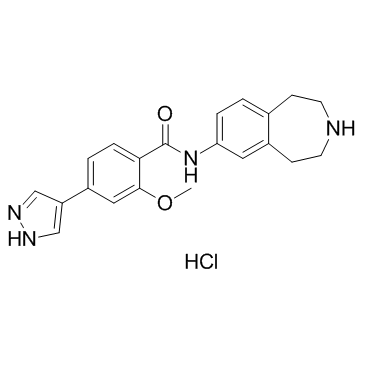JNJ-47117096 hydrochloride (MELK-T1 hydrochloride) (Synonyms: MELK-T1 hydrochloride) |
| Catalog No.GC32995 |
JNJ-47117096 hydrochloride (MELK-T1 hydrochloride) is potent and selective MELK inhibitor, with an IC50 of 23 nM, also effectively inhibits Flt3, with an IC50 of 18 nM.
Products are for research use only. Not for human use. We do not sell to patients.

Cas No.: 1610536-69-0
Sample solution is provided at 25 µL, 10mM.
JNJ-47117096 hydrochloride is potent and selective MELK inhibitor, with an IC50 of 23 nM, also effectively inhibits Flt3, with an IC50 of 18 nM.
JNJ-47117096 hydrochloride is potent and selective MELK inhibitor, with an IC50 of 23 nM, also effectively inhibits Flt3, with an IC50 of 18 nM, and slighitly blocks CAMKIIδ, Mnk2, CAMKIIγ, and MLCK (IC50, 810 nM, 760 nM, 1000 nM, 1000 nM). JNJ-47117096 (MELK-T1) suppresses the proliferation of Flt3-driven Ba/F3 cell lines, with an IC50 of 1.5 μM in the absence of IL-3, while no inhibitory activity is observed in the presence of IL-3. JNJ-47117096 does not inhibit the proliferation of Ba/F3 cell lines transfected with either FGFR1, FGFR3, or KDR, either in the presence or absence of IL-3[1]. JNJ-47117096 (MELK-T1, 10 μM) delays the progression of MCF-7 cells through S-phase. JNJ-47117096 inhibits MELK, and then exerts stalled replication forks and DNA double-strand breaks (DSBs). JNJ-47117096 activates the ATM-mediated DNA-damage response (DDR). JNJ-47117096 (3, 10 μM) results in a growth arrest and a senescent phenotype. Moreover, JNJ-47117096 induces a strong phosphorylation of p53, a prolonged up-regulation of p21 and a down-regulation of FOXM1 target genes[2].
[1]. Johnson CN, et al. Fragment-based discovery of type I inhibitors of maternal embryonic leucine zipper kinase. ACS Med Chem Lett. 2014 May 23;6(1):25-30. [2]. Beke L, et al. MELK-T1, a small-molecule inhibitor of protein kinase MELK, decreases DNA-damage tolerance in proliferating cancer cells. Biosci Rep. 2015 Oct 2;35(6). pii: e00267.
Average Rating: 5 (Based on Reviews and 19 reference(s) in Google Scholar.)
GLPBIO products are for RESEARCH USE ONLY. Please make sure your review or question is research based.
Required fields are marked with *




















